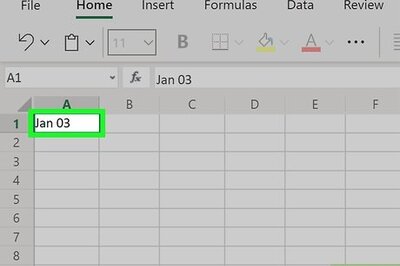
views
In the months of waiting from the time we had seen the first Nano at the Auto Expo to now, Tata has offered a glimpse repeatedly into the future of Nano. Here is all the information on the powertrain front.
1. The 3-cylinder engine
Tata's plan for a three-cylinder engine for the Nano surfaced with the Nano Europa at Geneva 2009. The logic is pretty simple. The Europa is a bigger car than the Nano and will have far more mandatory equipment on board – ESP, Airbags, ABS etc.
It will also have to run at significantly higher average and peak speeds than the Indian Nanos, which means a powerful motor, relatively speaking, becomes essential to the whole package. Tata's 35PS two-cylinder parallel twin, one must assume isn't going to cut it. Or, even if it did meet the requirement, the Nano team obviously thought something bigger would be nice.
In packaging terms, a three-cylinder parallel twin shouldn't add too much to the actual dimensions of the engine – although we would reckon that almost all of the extra length of the Nano, is being given over to the space the new motor needs.
Perhaps the simplest solution, on the face of it, is an engine that isn't all-new, but an extension of the current motor. If that assumption, our assumption, is correct, that this should point to an engine of between 800-950cc, which should bring the horsepower count up to about 42-48PS. And this should give the heavier, bigger Nano just enough juice to hit 130kmph, which is not an incidental top speed, it is the speed limit on most of Europe’s auto-routes.
2. The Diesel
Japan is actually the country famous for its small super-diesels. Their kei-jidosha (smallest car class) vehicles have always had 660cc engines or thereabouts, so a small diesel, in that sense isn't ground-breaking new technology.
However, if we assume that Tata met the same resistant that they got when they were trying to outsource the development of their 624cc petrol twin, then the diesel would also have had to be setup in house. Again, the engine capacity isn't known, but it would be reasonable to assume a similar displacement, since the space to squeeze the motor is in limited.
Now, given the cost angle, we aren't expecting a common-rail motor, although truth be told, we would be over the moon to see one in the spec list. However, if Tata have managed to extract good torque from the petrol engine, it should be able to at least get 30-40 per cent more from the diesel, which is roughly the norm in similar sized petrols and diesels when they are shared on one model across manufacturers.
PAGE_BREAK
Horsepower will probably not dip below the 35PS mark, in our estimation, and that should make the diesel Nano, dare we say it, a bit of a pocket rocket!
3. The Hybrid
This is very much the hot topic of the moment. There is intense speculation that the Tata Nano will have a hybrid version. If you think about it, perhaps the biggest problem for Tata, hybrid wise will probably be packaging, not implementation, technology or its application.
A hybrid, whether series (car starts electric, uses motor to charge batteries only, or only when serious acceleration is needed) or parallel (electric motor supplements normal engine, but the motor is not actually charged – in most cases – directly by the normal engine), will give the Tata Nano incredible fuel economy.
In theory, the world's cheapest car could also be the world's most fuel efficient production car! Now, the petrol engine fuel economy figure being bandied about seems to hover from 20 to 25 kpl. Even a mildly good hybrid arrangement should boost that figure by at least 20 per cent, which means 24 to 30kpl. Does that not sound good?
Like all hybrids do, the hybrid goodness of the Nano will come at a cost, and we expect that the Nano Hybrid, should it actually happen, will cost more than the fully-loaded petrol model even. At that price, it will become the cool, unobtanium Nano as it were.
That, alone, we say, is a good reason to make it. Elitist variant of a popular car? Oh yes. Oh, and Tata's mileage claims and CO2 claims with the petrol engine already match or surpass famous hybrids like the Prius et al, just so you know.
PAGE_BREAK
4. Electric
Thanks to Tata's work with their Norwegian partner, Miljo (think Th!nk) on the Indica EV, this is an actual possibility. Tata will launch the Indica EV in Norway in September according to reports and the only reason they aren't brining the 200km to a charge car to India is the lack of infrastructure to support it. In time, this will come, and so should the electric Nano.
There isn't any official word on this, so we'll stick our necks out one more time and say that the electric Nano is at least five years away – Tata will need the next 18-24 months or so just to stabilise the production and meet the demand for the petrol Nano. By that much time, hopefully, compact, high energy-density batteries and powerful motors should give the electric Nano performance comparable to or better than the incoming petrol Nano.
5. Air engine
Yes, Tata have been working with that quirky French firm, MDI, which has pioneered an engine that runs on compressed air. To understand more about how the engine works, please read the April 2009 issue of Overdrive. The upshot is that the engine runs more or less like a conventional engine in feel, but the fuel you put into the tank, literally, is air.
If (when?) the Nano gets that engine, it will need a tiny amount of normal fuel for on-board air compression at best. This car, then, will be truly stonking, for it will drink almost nothing, produce fresh, totally pure air and cost next to nothing to run.



















Comments
0 comment